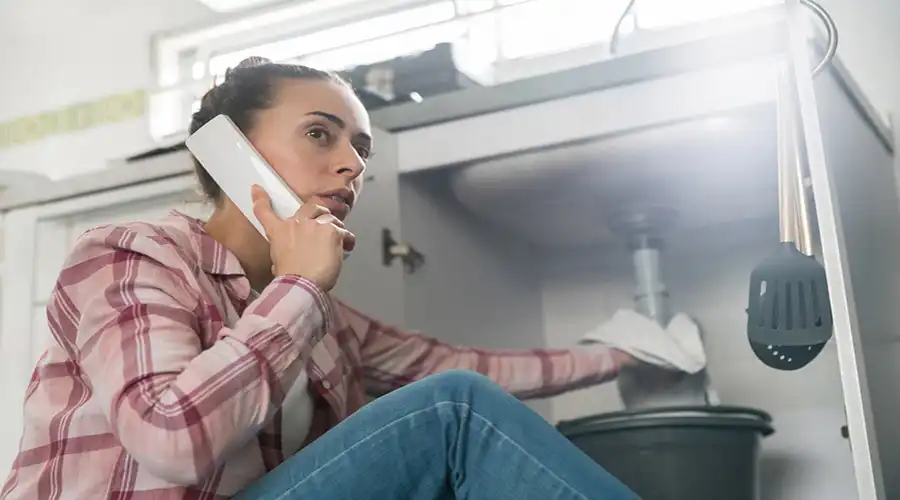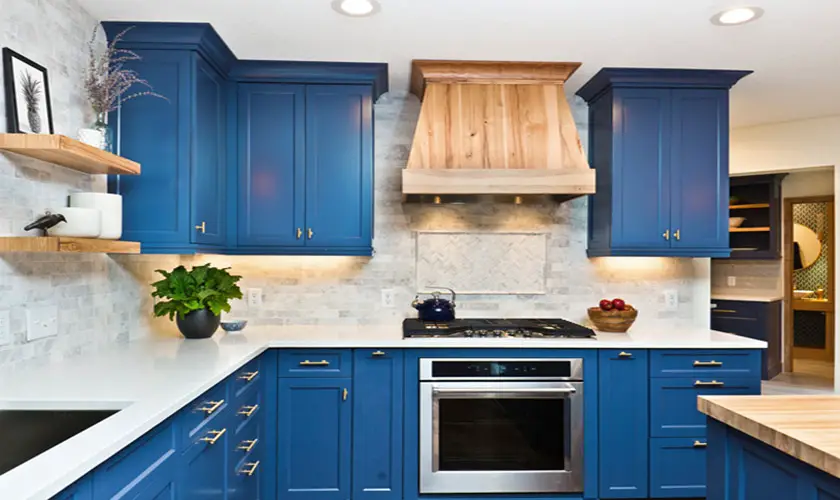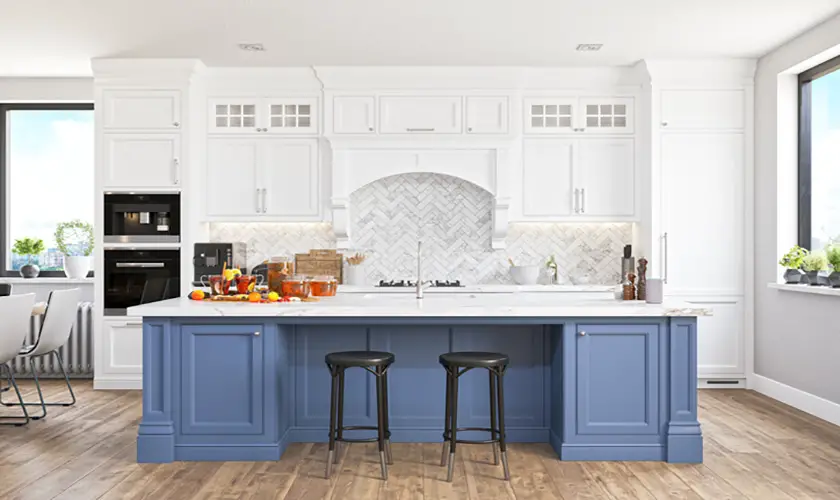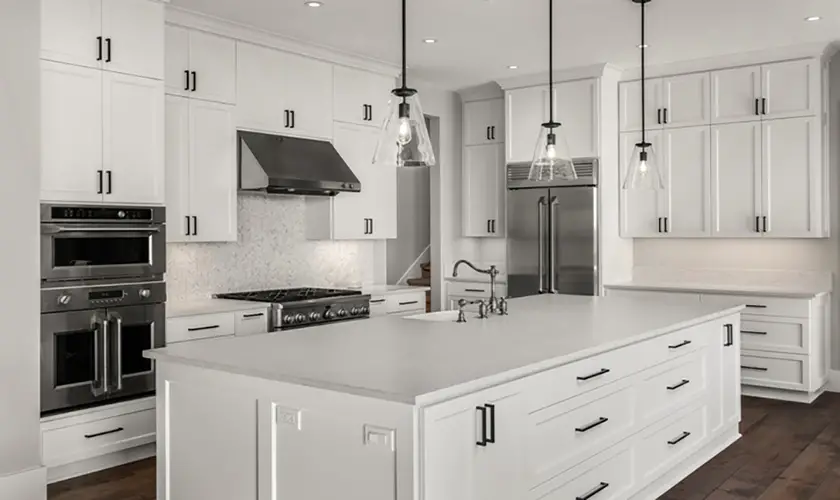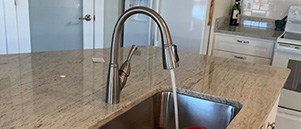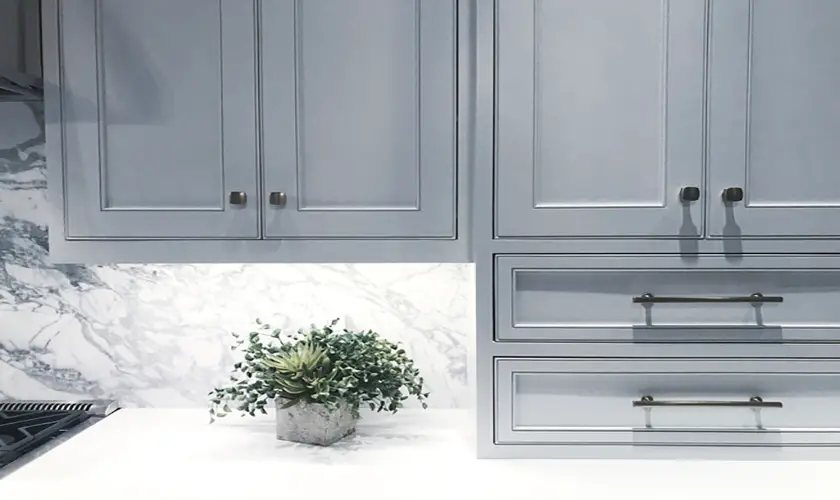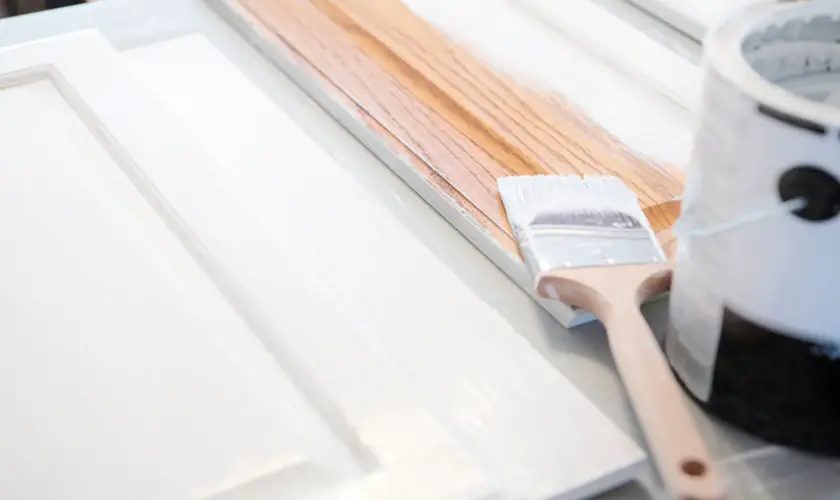Garbage disposals are one of the handiest, if not most problematic, appliances in your kitchen. They’re a great way to get rid of unwanted food particles and waste, but people often try to put things down at their disposal that don’t belong there. For this reason, clogged garbage disposal is a very common occurrence.
You might clog your garbage disposal for several reasons, and you’ll use similar remedies for all of them. You can use natural remedies, chemicals, or store-bought tools to unclog your disposal. It’s always best to start with the least invasive method and work down the list to more invasive remedies.
If you’re in the middle of a garbage disposal clog, you’ve come to the right place. This article will discuss why your garbage disposal has problems, particularly with clogs, and how to fix them. Let’s get plumbing!
Get FREE quotes from licensed Plumbers in your area today. Whether you need a new water heater, a sink repair, or a toilet fixed, We Can Help! All Plumbers are screened, licensed, and insured.
Common Causes for Garbage Disposal Clogs
Several things can lead to a clogged garbage disposal, which is preventable. Understanding the main causes of clogs is the best way to keep from causing them in the first place.
Improperly Using the Disposal
To use a garbage disposal properly, always have running water. If your garbage disposal is grinding food without enough water, it will likely get clogged. Running your disposal without water can damage it.
Putting Foreign Objects Into the Disposal
The next way disposals get clogged and stop working is by sticking foreign objects into them. It happens a lot that things like forks, knives, spoons, or small toys fall into the sink drain by accident. If you start the disposal unaware of this object, you’ll likely damage the impeller blades and clog the disposal unit or drain pipe.

Putting the Wrong Food Into the Disposal
The main reason garbage disposals get clogged is because people don’t know what foods can’t go in. They get designed to handle soft food scraps and liquids rather than anything and everything in your fridge or pantry. Here are some foods and things that you should never put into your disposal.
- Coffee grounds
- Banana peels
- Potato peels
- Fibrous foods
- Potato skins
- Fruit pits
- Large food particles
- Corn cobs or corn husks
- Too much food at a time
Hot Water While Using the Disposal
To properly use your garbage disposal, use the correct water type and temperature. Disposal clogs often occur when you use hot water instead of cold water while running your disposal. Hot water tends to spread fat, grease, and oils around inside the disposal, which can also cause a clog.

How to Unclog a Garbage Disposal
Now that you know better what’s causing your clog, let’s dive into ways to fix the problem.
Turn Off the Power
The first thing you’ll want to do when working on your garbage disposal is kill the power to it. Like other appliances, disposals use electricity. Working on them while they’re live could shock you. To turn off the power, locate your panel box and flip the circuit breaker that controls the disposal to the OFF position.
Perform a Visual Inspection
After the power gets turned off at the main panel box, you’re ready to dig into diagnosing and fixing the issue. The first thing you should do is inspect the clogged sink drain. Shine a
Use a Plunger
If you can’t see an object in the drain, there’s a good chance the clog is further down the line and not happening at the actual disposal. Your next step should be to take a toilet plunger and use it as a sink plunger. Place the plunger entirely over the kitchen sink drain on the side of your disposal, and start plunging. Work this handy tool as you would with a plugged toilet by pushing it up and down.
A plunger sucks on the drain and circulates enough to push the blockage out. The plunger method will also work if you have standing water in your sink and need to unclog it.
Try Baking Soda and Vinegar
If you’re sure your clog is caused by food items, baking soda, and vinegar is the best way to remediate the situation. These two household items are some of the handiest and most versatile products in your pantry. They’re great for cooking, cleaning, and even unclogging a sink or drain.
To use this concoction, pour ½ to 1 cup of white vinegar into the clogged drain, followed by ¼ to ½ a cup of baking soda. Give the mixture 10 to 20 minutes to work its magic before following it up with a gallon of boiling water. If your clog results from food particles, fat, grease, or oil, this concoction will likely take care of it.
Use Chemical Drain Cleaners
If baking soda, vinegar, and hot water don’t do the trick, you may have to use chemical drain cleaners. These strong cleaners can harm your drain pipes and damage plastic parts in your system. It depends on what they’re made of.
Your best bet when it comes to chemical cleaners is to use Drano. Because there are many different types of Drano, choose the right one for your purposes. Once you have your Drano, follow the instructions for your specific product and attempt to reduce the clog.
Hex Wrench or Wooden Handle Method
If pouring things down the drain doesn’t work, you can turn the garbage disposal blades. Most disposals have a hexagonal hole on the bottom of the disposal that you can access by lying on your back and poking your head under your sink. Turning the blades is a great way to loosen them if they’re over-tightened or bound up.
When you buy a garbage disposal, it usually comes with a hex wrench, also known as an Allen wrench. They do this because disposal clogs are common, and manipulating the blades is an excellent way to fix them. Before turning the blades, it is crucial to first cut power to the disposal.
- Locate the hexagonal hole on the bottom side of your disposal.
- Use the Allen wrench that came with the disposal or find another one that fits the hole.
- Insert the wrench into the disposal and turn it clockwise and counterclockwise. You’re trying to work the blades back and forth to free them up if they’re jammed.
- Once the blades start to spin with each turn, it’s a good sign that you fixed the jam.
- Recheck the drain opening with a
flashlight to see if there are any visible pieces of food or debris and remove them.
- If your disposal doesn’t have a hexagonal hole at the bottom of the disposal, you can use a broom handle or wooden spoon to achieve the same ends.
- Insert the wooden handle into the disposal and manually move the blades back and forth until they start to turn.
- Perform a visual inspection of the inside of the sink and remove any debris or particles that you see.
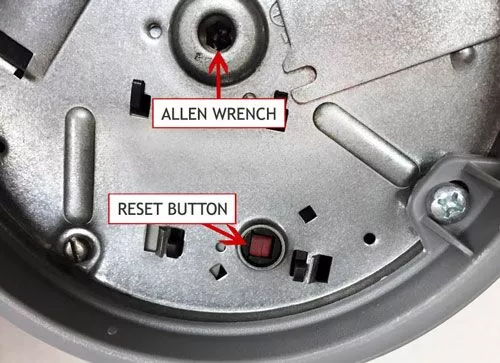
The Reset Button
Another thing that you can try depending on how modern your disposal is is pressing the reset button. Not all disposals have this feature, but the reset button is the easiest way to fix a clogged garbage disposal if yours does.
Clean the P-Trap or Drain Trap
If nothing you’re doing is fixing the clog and you’re at your wit’s end, cleaning the p-trap on your kitchen drain is your last option before calling a professional plumber. Cleaning the p-trap is the most in-depth garbage disposal repair, but it’s also one of the most common. Here’s what you need to know.
- The P-trap is on the side of your garbage disposal and has the shape of a U.
- Before loosening the trap fittings, put a bucket underneath the trap to capture any water sitting inside.
- Next, use a set of Channellock pliers to loosen the union on the trap, or you can manually loosen the slip nut fittings if that’s the style of your pipes.
- Once the fittings are loose, you can manually remove the trap from underneath the sink.
- Use a soft scrub brush, coat hanger, wire hanger, or drain snake to remove clogs from within the trap manually.
- If you check the trap, but it doesn’t appear to be clogged, the problem is likely in the trap arm. The arm is the small section of pipe that connects the trap to the side of the disposal.
- Loosen and remove the trap arm and perform the same cleaning methods on it.
- If the trap arm and p-trap appear intact and clog-free, the problem is likely to further down the drain line.
- Use a drain or plumbing snake and work it through the pipes downstream from the p-trap.
- Make sure to work the auger slowly down the drain so you don’t damage your pipes. Worm it back and forth as needed and repeat the process until you’re satisfied that the clog gets removed.
- Once you’re finished, it’s time to reassemble the p-trap, trap arm, and the rest of your drain and garbage disposal.
- With everything reassembled, flush the system with a steady stream of cold water and attempt to operate your disposal. You’re good to go if everything checks out and your disposal is working.
Important Tips for Garbage Disposal Maintenance
To avoid disposal issues or buying a new one, you must maintain your current garbage disposal. While not putting things into your disposal that you shouldn’t is a good start, there are other things you can do to protect it.
- Use your disposal regularly.
- Only run cold water when you’re using your disposal.
- Avoid putting the foods listed above into your disposal.
- Perform regular checks on your sink drain to ensure that foreign objects haven’t fallen inside.
- Never over-fill or stuff the disposal with food items. Feed disposal-safe items into the disposal one at a time and wait until you hear the typical garbage disposal hum before inserting a new item.
- Have your water running full force when operating your disposal. Not enough water isn’t much better than no water at all.
- Clean your disposal every two weeks by pouring Dawn dish soap, vinegar, baking soda, and cleaners into the disposal and turning it on. Always accompany these things with cold water.
- Running dawn dish soap and tiny amounts of orange, lemon, or lime peels is a great way to prevent food odors from wreaking havoc on your kitchen.
Clogged Garbage Disposal FAQs
How do you clear a clogged garbage disposal?
1. Turn Off Disposal: Ensure the unit is off for safety.
2. Press Reset: Hit the reset button on the unit.
3. Manually Rotate: Use an Allen wrench to turn the blades.
4. Plunge: Use a plunger to dislodge the clog.
5. Baking Soda and Vinegar: Pour down the disposal, wait, then rinse with hot water.
6. Boiling Water: Follow up with boiling water to clear residue.
7. Clean P-trap: Remove and clean the P-trap under the sink.
8. Remove Obstructions: Use pliers to remove any visible foreign objects.
9. Call a Plumber: If the clog persists, seek professional help.
Is it OK to unclog garbage disposal?
Yes, it is generally okay to unclog a garbage disposal as long as you take the proper safety precautions.
Why is my garbage disposal humming but not working?
If your garbage disposal hums but doesn’t grind, it’s likely jammed or the motor is malfunctioning. Here’s a quick fix:
1. Turn Off Power: Always switch off the disposal at the circuit breaker first.
2. Press Reset: Hit the reset button on the bottom of the unit.
3. Manually Rotate: Insert an Allen wrench into the bottom and twist to free up the blades.
4. Remove Obstructions: Use pliers to remove any debris causing the jam.
5. Call for Help: If it’s still not working, the motor may need professional attention.
How do I check if my garbage disposal is clogged?
To check for clogged garbage disposal:
1. Listen: A humming sound without grinding means a possible jam.
2. Observe: Slow drainage indicates a clog.
3. Inspect: With power off, use a flashlight to look for blockages.
4. Test Blades: Gently try to rotate blades with a wooden implement; resistance suggests a clog.
5. Reset Button: If it’s popped out, the disposal may be clogged or overloaded.
Is it okay to put citrus fruit peels at my disposal?
In very small amounts, it’s okay and beneficial to run citrus fruit peels through your garbage disposal.
What’s the easiest way to unclog a garbage disposal?
The easiest way to unclog your garbage disposal is to press the reset button on the side or bottom. However, if your disposal has no reset button, you should follow the steps above to fix your clog.
What does it mean if I smell bad food coming out of my disposal and draining slowly?
If you smell rotten food coming out of your disposal, accompanied by a slow drain, food is likely clogging your disposal or drain pipes.
Final Thoughts
Your garbage disposal could be clogged for many reasons, but solutions exist. Start with gentle methods like the reset button or a plunger. If those don’t work, then try more thorough solutions.
Get FREE quotes from licensed Plumbers in your area today. Whether you need a new water heater, a sink repair, or a toilet fixed, We Can Help! All Plumbers are screened, licensed, and insured.


